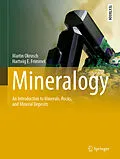This book presents a translation and update of the classic German textbook of Mineralogy and Petrology that has been published for decades. It provides an introduction to mineralogy, petrology, and geochemistry, discussing the principles of mineralogy, including crystallography, chemical bonding, and physical properties, and the genesis of minerals in a didactic and understandable way. Illustrated with numerous figures and tables, it also features several sections dedicated to the genesis of mineral resources. The textbook reflects the authors' many years of experience and is ideal for use in lectures on mineralogy and petrology.
Autorentext
Martin Okrusch was born in 1934 in Guben, Germany, and studied Geosciences at the Free University of Berlin and the University of Würzburg, Bavaria. After having obtained his doctoral degree in 1961 and his Dr. rer. nat. habil. in 1968, he worked as a guest researcher at the University of California at Berkeley in 1968/1969 and became an associate professor at the University of Cologne in 1970. He was a full professor at the Technical University of Braunschweig from 1972 to 1982, and at the University of Würzburg from 1982 until his retirement in 2000. Since then he has continued to work on research projects in metamorphic and igneous petrology.
Hartwig Frimmel, born in 1960 in Linz, Austria, received his PhD in Geology and Petrology from the University of Vienna in 1987. Since 2004 he has been a full professor at the University of Würzburg, Bavaria, where he holds the Chair in Geodynamics and Geomaterials Research. He is an honorary research associate at the University of Cape Town, South Africa, where he rose from lecturer to associate professor between 1989 and 2004. From 1998 to 2004 he was the leader of the Earth Science subprogramme of the South African National Antarctic Programme. He is a former president of the Society for Geology Applied to Mineral Deposits (SGA) and advisor at the national and European level on matters concerning mineral deposits. His main research interests range from economic geology, metamorphic petrology, Precambrian palaeoclimate and palaeogeography, to sedimentary geochemistry and the role of early life in metallogenesis.Inhalt
Part I
Introduction and basic concepts
1 Crystals
1.1 Crystal morphology
1.1.1 Symmetry operations and symmetry elements
1.1.2 Crystal systems and classes
1.1.3 The Law of rational indices
1.2 Crystal structure
1.2.1 Bravais lattices
2.2.2 Space groups
2.2.3 Determination of crystal structures by X-ray diffraction
1.3 Crystal chemistry
1.3.1 Basic concepts
1.3.2 Types of chemical bonds
1.3.3 Some important terms of crystal chemistry
1.4. Physical properties of crystals
1.4.1 Hardness and cohesion
1.4.2 Thermal conductivity
1.4.3 Electric properties
1.4.4 Magnetic properties
1.5 Optical crystallography
1.5.1 Basic bonds
1.5.2 Basic principles of microscopy in transmitted light
1.5.3 Basic principles of microscopy reflected light
References
2 Minerals
2.1 Definition of the term mineral
2.2 Identification and classification of minerals
2.3 Mode of occurrence
2.4 Rock-forming and economic minerals
2.4.1 Rock-forming minerals
2.4.2 Economic minerals
2.4.3 Gemstones
2.5 Biomineralisation and medical mineralogy
2.5.1 Biogenic mineral formation
2.5.2 Medical mineralogy
References
3 Rocks
3.1 Mineralogical composition of rocks
3.2 Relationships between lithogeochemistry and mineralogy
3.3 Rock fabric
3.3.1 Texture (microstructure)
3.3.2 Structure
3.4 Field relationships
3.5 Principal rock-forming processes
3.6 Mineral deposits
References
Part II
Systematic mineralogy - a selection of important minerals
4. Elements
4.1 Metals
4.2 Metalloids (semi-metals)
4.3 Non-metals
References
5 Sulfides, arsenides and complex sulfides (sulfosalts)
5.1 Metal su^ 1:1 (generally 2:1)
5.2 Metal sulfides and arsenites with M:S = 1:1
5.3 Metal sulfides, sulfarsenides and arsenites with M:S = 1:2
5.4 Arsenic sulfides
5.5 Complex metal sulfides (sulfosalts)
References
6 Halides
References
7 Oxides and hydroxides
7.1 M2O compounds
7.2 M3O4 compounds
7.3 M2O3 compounds
7.4 MO2 compounds
7.5 Hydroxides
References
8 Carbonates, nitrates, borates
8.1 Calcite group 32/m
8.2 Aragonite group 2/m2/m2/m
8.3 Dolomite group
8.4 Azurite-malachite group
8.5 Nitrates
8.6 Borates
References
9 Sulfates, chromates, molybdates, wolframates
9.1 Sulfates
9.2 Chromates
9.3 Molybdates and wolframates
References
10 Phosphates, arsenates, vanadates
References
11 Silicates
11.1 Orthosilicates (nesosilicates)
11.2 Disilicates (sorosilicates)
11.3 Ring silicates (cyclosilicates)
11.4 Chain silicates (inosilicates)
11.4.1 Pyroxenes
11.4.2 Pyroxenoids11.4.3 Amphiboles
11.5 Sheet silicates (phyllosilicates)
11.5.1 Pyrophyllite-talc group
11.5.2 Mica group
11.5.3 Hydro-mica group
11.5.4 Brittle mica group
11.5.5 Chlorite series
11.5.6 Serpentine group
11.5.7 Clay minerals
11.5.8 Apophyllite group
11.6 Framework silicates
11.6.1 SiO2 minerals
11.6.2 Feldspar family
11.6.3 Feldspathoids
11.6.4 Cancrinite group
11.6.5 Scapolite group
11.6.6 Zeolite family
References
12 Fluid inclusions in minerals
References
Part III
Petrology and metallogenesis
13. Igneous rocks
13.1. Classification of igneous rocks
13.1.1 Principal classification based on geological position and fabric
13.1.2 Classification based on mineralogy
13.1.3 Classification based on bulk chemical composition
13.2 Petrography of igneous rocks
13.2.1 Subalkaline magmatic rocks
13.2.2 Alkaline magmatic rocks
13.2.3 Carbonatite, kimberlite and lamproite
References
14 Volcanism
14.1 Effusive volcanism: lava flows
14.2 Extrusive volcanism
14.3 Explosive volcanism
14.4 Mixed volcanic activity: stratovolcanoes
14.5 Volcanic exhalations
References
15 Plutonism
15.1 Volcanic roots and magma chambers
15.2 Shapes of plutonic and subvolcanic intrusive bodies15.3 Internal structure and emplacement of intrusive bodies
15.3.1 Internal structure of plutons
15.3.2 Emplacement mechanisms
15.3.3 Layered intrusions
References
16 Magma and lava
16.1 Chemical composition and structure of magma16.2 Volcanic gases
16.3 Temperatures of magmat
16.3.1 Direct measurement by pyrometry
16.3.2 Melting experiments on natural rocks
16.4 Viscosity of magmas and lavas
16.5 Solubility of volatiles in magma
References
17 Formation and evolution of magmas
17.1 Magma series
17.2 Primary and parental melts
17.2.1 Primary basaltic melts
17.2.2 Granitic melts
17.3 Magma mixing
17.4 Magmatic differentiation
17.4.1 Fractio…
